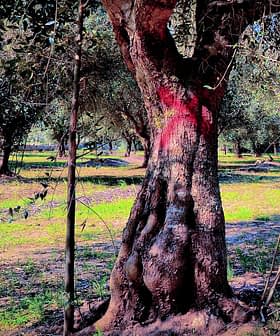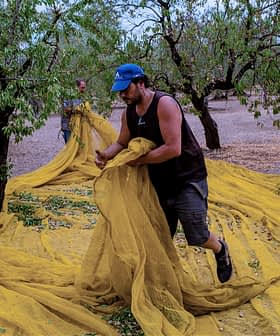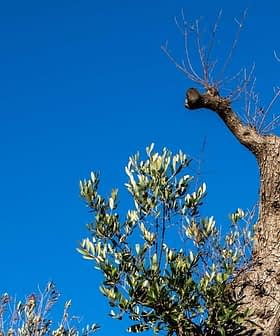Researchers from various universities developed an economic model to validate the long-term impact of Xylella fastidiosa (Xf) on the olive oil industries of Spain, Italy and Greece. They found that the potential cost could be measured in billions of euros if the spread of the disease is not mitigated effectively.
Olive quick decline syndrome could cost billions of euros over the next 50 years in Greece, Italy and Spain.
The possible loss for Italy was estimated at €5 billion ($5.42 billion) over the course of 50 years, while Spain and Greece were likely to suffer losses of 17 billion euros ($18.44 billion) and 2 billion euros ($2.17 billion) respectively over the same time period.
Xf is one of the most dangerous plant-pathogenic bacteria worldwide, the researchers noted. It causes quick decline syndrome on olive trees and many other plant species. In the European Union alone, over 84 host plants for the pathogen have been identified so far.
See Also:Spain Deploys New Technology to Combat Olive Tree Pathogens“Olive quick decline syndrome could cost billions of euros over the next 50 years in Greece, Italy and Spain,” lead study author Kevin Schneider, of the Wageningen University in the Netherlands, told Olive Oil Times. “Even under slow disease spread and the ability to replant with resistant cultivars, projections of future economic impact in affected countries run in the billions of euro.”
For the sake of the research, a bio-economic model was constructed for the strain of the bacterium detected in Apulia. The model combined data from climatic-suitability modeling, simulations of the disease spread based on radial range expansion, and an algorithmic method to compute the economic impact on olive growers.
An assessment period of 50 years was selected due to the slow rate of development of olive trees, and different introduction points and dispersal rates of the pathogen were fed to the model to simulate the future spread of the disease. The spread of the disease was calculated at 5 kilometers (3.1 miles) per year on average, likely to be reduced to 1 kilometer (.62 miles) per year with the application of proper control measures. Different simulating scenarios accounted for variations in the dispersal rate.
Results showed that almost all producing territories are susceptible to infection from Xf, with the affected area varying between 85 and 99 percent of the olive groves of each country. Furthermore, an escalation of the disease matching the simulations would cause great economic damage to olive growers and producers. Replacing the affected olive trees with Xf-resistant cultivars would limit the damage considerably.
“The findings suggest that most European production sites fall into the climatically suitable territory for establishment and dispersal of the disease,” Schneider explained. “In Italy, cessation of production after orchard die-off results in an economic impact of up to €5.2 billion ($5.7 billion) if the pathogen spreads beyond the current extent. Replanting orchards with resistant varieties can lower the impact to €1.6 billion ($1.7 billion). Reducing the annual rate of spread could save up to €1.3 billion ($1.4 billion). Introductions into Greece and Spain could result in an impact between €2 billion and €17 billion ($2.2 billion and $18.4 billion), respectively.”
The three countries were the most suitable for the research scope as together, they account for almost 95 percent of European olive oil production. Southern Italy is severely hit by Xf with almost 17 percent of its olive producing territories currently infected. Spain also suffers from the pathogen sporadically present on the mainland and in some islands, whereas Greece remains unaffected.
Schneider also specified that, due to its morphology, Greece exhibits an advantage over Italy and Spain in the case the pathogen manifests itself on a single entry point.
“We did find that impacts in Greece were lower than compared to Italy or Spain,” he said. “While this was influenced by a few factors, one key difference was the sea as a natural barrier for the spread between the areas of production. Albeit, that this is based on the assumption that we only consider one introduction of the pathogen and not multiple introductions.”
A cure for Xf has yet to be discovered, Schneider added, emphasizing that planting of resistant cultivars, along with control measures, appeared to be effective in controlling the spread of the bacterium.
“Currently, there is no practical cure under field conditions,” he said. “While important research on vector control is ongoing, adaptation through resistant trees seems the most promising long-term strategy. The findings stress the necessity to strengthen the ongoing research on cultivar resistance traits and application of phytosanitary measures including vector control and inoculum suppression by removing host plants.”
Furthermore, many olive trees surrounding pockets of infected trees can be asymptomatic, infected with the pathogen but exhibiting no symptoms of the disease. The study recommended that a cordon sanitaire should be created in the perimeter of those pockets by removing the symptomless trees. The study stressed that the asymptomatic, but infectious, olive trees pose a significant hindrance to a possible eradication of the disease.
Unpopular practices like felling seemingly healthy olive trees can, however, result in “great societal unrest in the affected region,” the researchers warned.
Schneider also acknowledged the strictly scientific approach of the study, leaving aside the cultural side of the olive tree groves of Europe.
“The study did not account for the cultural heritage value of the European olive trees, many of which are hundreds of years old,” he said.
Schneider urged olive growers to seek official advice and apply the proper measures in cooperation with the authorities.
“Farmers need to stay vigilant and adhere to the imposed mitigation measures. Government interventions are warranted with regard to economic considerations, and government support for adaptation strategies, such as [developing and propagating] resistant varieties, is important,” he said


 Apr. 20, 2020 11:50 UTC
Apr. 20, 2020 11:50 UTC Costas Vasilopoulos
Costas Vasilopoulos




